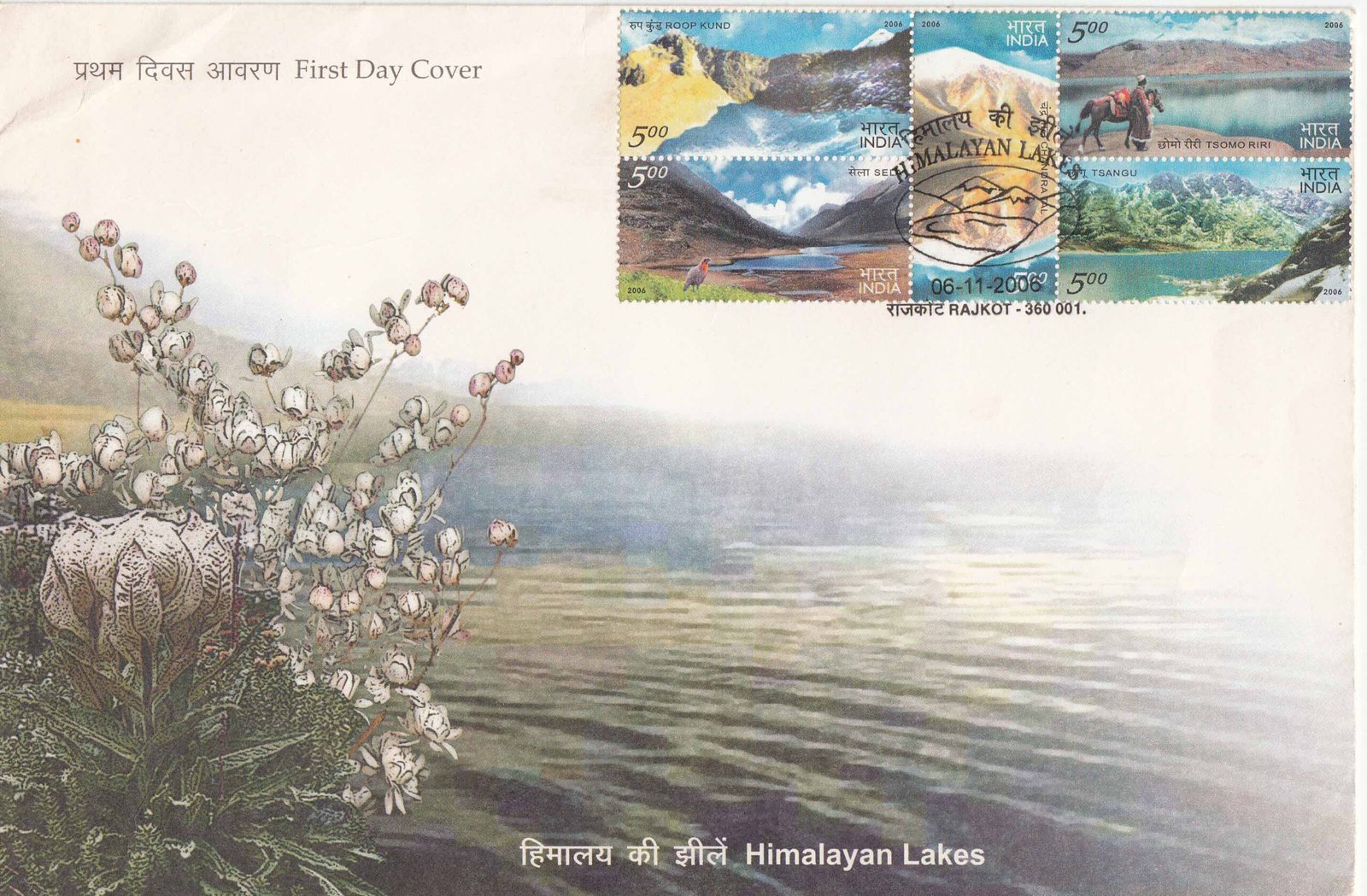Himalayan Lakes- Roop Kund

Technical Data
| Stamp Set | Himalayan Lakes |
|---|---|
| Date of Issue | November 6, 2006 |
| Denomination | Rs. 5 |
| Quantity | 3,000,000 |
| Perforation | line13¼ |
| Printer | India Security Press, Nasik |
| Printing Process | Photogravure |
| Watermark | No Watermark |
| Colors | Multicolor |
| Credit (Designed By) | Sh. Bharati Mirchandani |
| Catalog Codes |
Michel IN 2165 Stamp Number IN 2172a Yvert et Tellier IN 1930 Stanley Gibbons IN 2354 WADP Numbering System - WNS IN047.2006 |
| Themes | Lakes | Landscapes | Mountains |
The word ‘lake’ conjures up a vision of blue, tranquil waters, boats with semi-recumbent revelers, and other paraphernalia of a tourist resort all set against a lush and beautiful backdrop. The lake eco-systems are, however, of significance and under threat. On the one hand they are vulnerable to pollution, and on the other hand their vulnerability means that they can be excellent sensors of environmental change.
Known for their pristine beauty, the Himalayan Lakes of India, surrounded by towering snowcapped peaks, have inspired travelers, pilgrims, painters and adventure seekers. From Jammu & Kashmir to Arunachal Pradesh, the Himalayan ranges are dotted with a galaxy of lakes of remarkable beauty. Most of these lakes are found at altitudes of less than 5000 meters and, interestingly, the size of the lakes diminish with altitude.
The Department of Posts has tried to capture the beauty and serenity of five Himalayan Lakes of India through this set of stamps.
One of the most classically beautiful lakes is the Chand ratal in Lahual and Spiti District of Himachal Pradesh that connects the areas of Spiti and Lahual. Surrounded by snows and acres of scree, this deep blue lake has a circumference of 2.5 KM and is the source of river Chandra. Situated at a breathtaking 4300 meters above sea level, the lake itself was probably formed at the end of the last ice age when the glaciers retreated, leaving behind considerable dead ice masses, which on melting formed large lakes. According to some believers, this is the spot from where the eldest Pandava brother Yudhishthir ascended the God Indra’s chariot which conveyed him to ‘Swarg’ (Heaven) in mortal form.
Roop Kund is situated at a height of 5029 meters from sea level on the lap of the Trisul Massif. This is called the ‘Mystery Lake’, after human skeletons and remains of horses were found here. This magnificent lake is surrounded by rock-strewn glaciers and snow-clad peaks.
Tsangu in Bhutia language literally means “the source”. This tranquil lake is located at an altitude of 12310 ft. on the Gangtok Nathula Highway. The lake is about 1 KM long, oval in shape, about 15 meters deep and is considered sacred by the people. It’s cool, placid waters mirror the enchanting beauty of the surrounding Alpine forests which are home to some rare animals like the Red Panda, the Brahminy Duck and a variety of other birds.
Sela Lake, which is also called Paradise Lake, is situated on the way to Tawang, alongside the world’s second highest motorable pass, i.e. Sela pass (13,714 ft. approx.) in Arunachal Pradesh. The height of the lake is approximately 13500 ft. The lake is in round shape and its circumference measures about 2.1 KM, and it is 6 meters deep. The lake abounds in trout and is surrounded by ice almost round the year.
The Tsomoriri Lake or ‘Mountain Lake’ is an enchanting expanse of water ringed by mountains, located about 240 KM from Leh, in Rupshu Valley of Jammu & Kashmir. The lake is situated at an altitude of about 4267 meter from sea level, near a small village called Korzok. 15 miles in length and 3-4 miles in width, the lake is home to many rare migratory birds. The area is rich in wildlife including the ‘Kyang’ (wild ass), red fox, and the snow leopard, and the lake area is also known for the colourful nomadic people who live there.
First Day Cover

